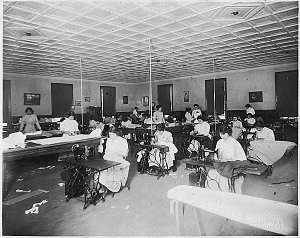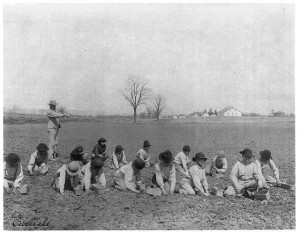Curriculum
Frederick Hoxie published a book titled, A Final Promise: The Campaign to Assimilate the Indians, 1880-1920, that describes the evolution of the view on assimilation. He argued that it went from Natives being able-bodied and independent enough to be included in every day life to a dependent people that needed government aid because they were unable to participate. In his book, Hoxie talked about the implementation of a strict, low level curriculum and its implications for how whites viewed Native Americans. Beginning in the 1880’s, government reform sought to educate Native Americans in a way that, “would simply give the Indians opportunities that were already available to other groups: jobs, schools, and citizenship;…a salutatory model to hold before other minority communities” (34). Education would provide for Natives a way to move up in society and be on a level playing field with the rest of America. It is worthy to note that even this “positive” kind of reform was still imposing a detrimental view upon Natives, viewing them as lesser and in need of improvement in the first place. This paternal view was reflected in the kind of curriculum that was being brought to schools in the first decade of the 1900s. Estelle Reel became superintendent in Spokane, Washington in 1898. In 1901, she created a curriculum for Indians that she thought catered to their needs. Her curriculum started with,
“‘light chores’; progressed through learning to ‘fix broken tools’…and culminated, in the fifth year, when students learned to plow…Her program covered additional fields such as baking (every girl should learn to bake bread and ‘must be taught how to cut bread into dainty, thin slices and place [them] on plates in a neat attractive manner’…” (196).
Her curriculum was low level ability and maintained that men were limited to farming jobs and women left to do household work. There was low expectations and extremely gendered classes. The other courses were, for example, canning, hygiene and upholstering. Reel’s education provided menial tasks that didn’t actually aid Native Americans in participating in middle and upper class work. They were limited to low paying, minimalistic jobs. Although these classes could be valuable to an extent, they set up Natives to plateau early and never go beyond these infantile classes. As Hoxie put it, “These institutions would do nothing to alter the Indians’ marginal economic existence or to equip tribesmen with skills that might enable them to challenge the political power of their non-Indian neighbors” (209). The idea of aiding Natives in becoming equals gradually morphed into the view that Natives were unable to adapt quickly and therefore were given an education that supported this notion to keep them under white domination. This in turn would lead them to low paying and inferior jobs. Amnesty International Magazine had an entry called “Soul Wound: The Legacy of Native American Schools”, and author Andrea Smith wrote, “In addition to bringing in income, the hard labor prepared children to take their place in white society — the only one open to them — on the bottom rung of the socioeconomic ladder” (Soul Wound, Smith). This kind of curriculum left Natives with no other choice but to accept subordinate positions, reinforcing the gap between whites and Natives.


June 1, 2023 at 3:39 am
you’ve got were given a high-quality weblog right here! Do you need to cook a few invite posts in this little blog? Cortexi